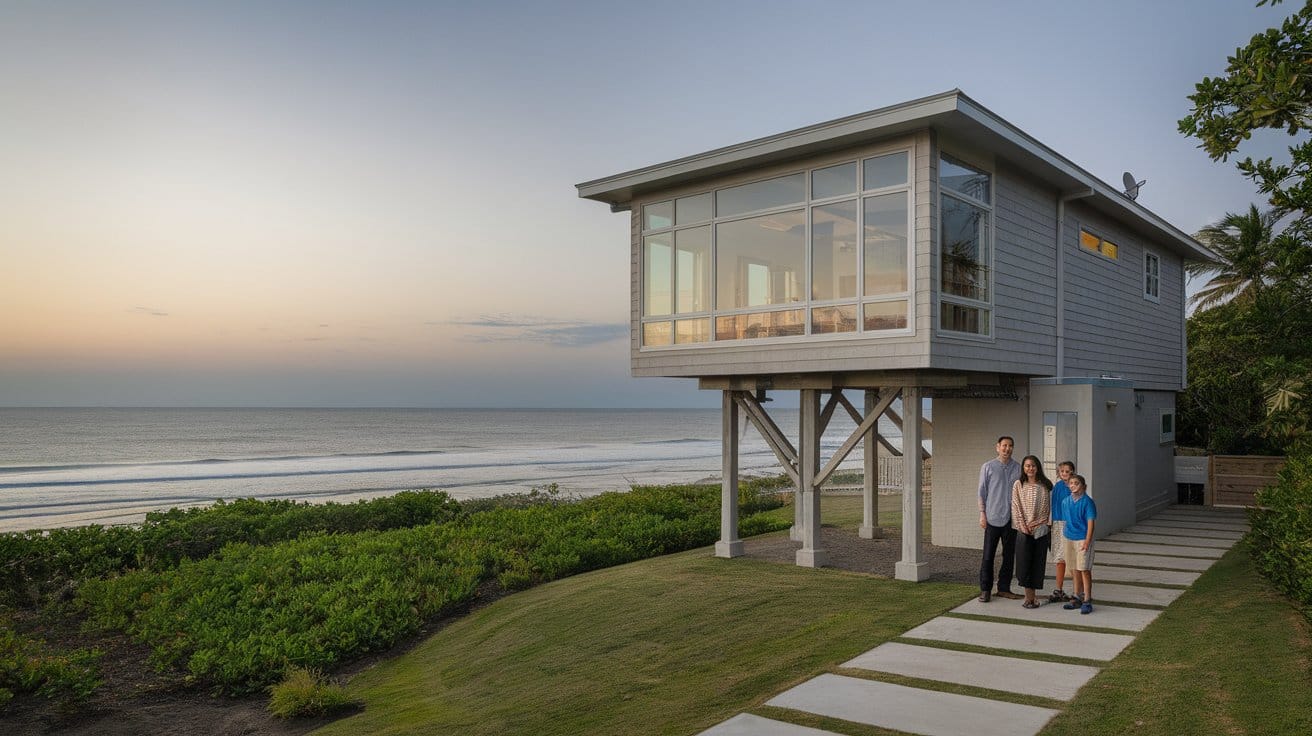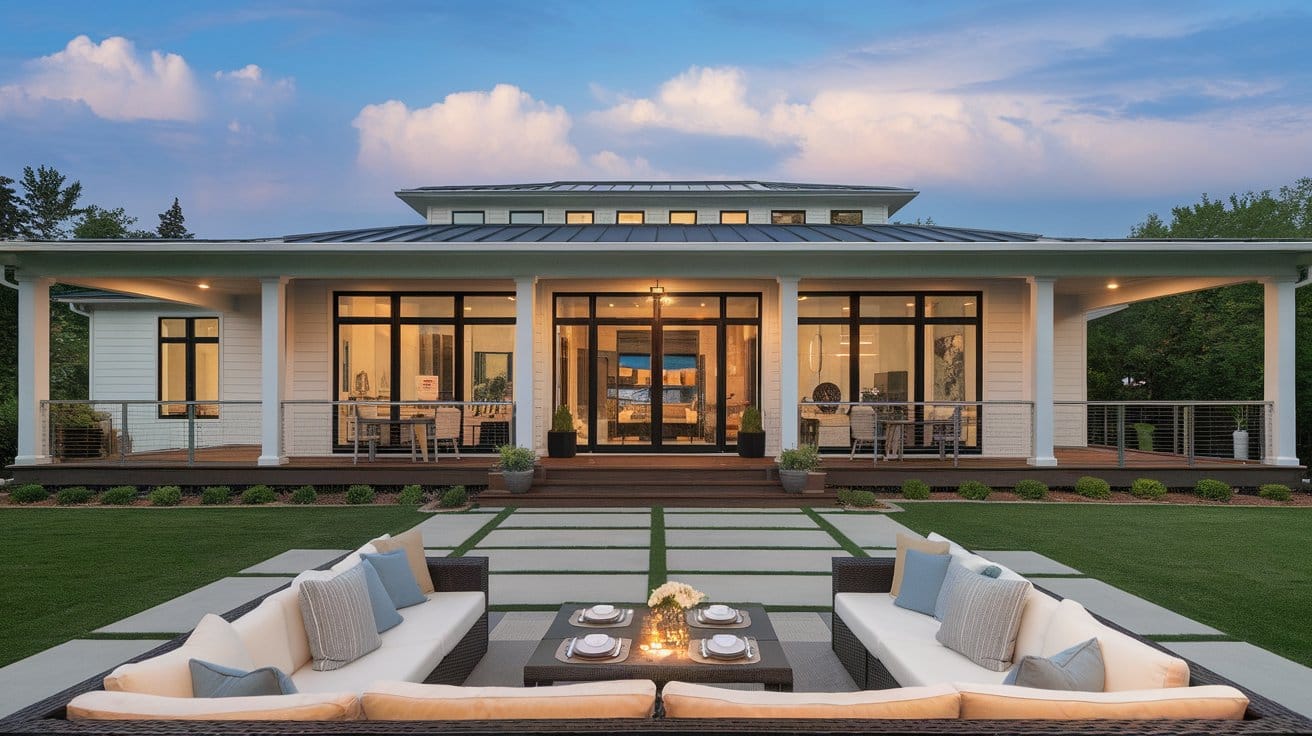[lasso rel=”amazon-66″ id=”4281″]
Introduction
In the quest for sustainability, eco-friendly housing stands out as a pivotal solution for the modern world. These homes, designed with sustainable materials and advanced energy efficiency, not only minimize environmental impact but also enhance living quality. As the housing market evolves, the demand for green building practices and environmentally friendly designs is accelerating. Whether through solar power installation or the integration of native plants into landscaping, the goal is to create sustainable homes that cater to both ecological and aesthetic needs.
The benefits of such developments are manifold. Utilizing solar energy, incorporating energy-efficient appliances, and opting for repurposed or prefab materials, homeowners can significantly reduce their reliance on fossil fuels. Moreover, the integration of sustainable home design elements like passive house features or zero-carbon home innovations is not just a trend but a necessary shift towards eco-friendly living. These practices not only promote sustainable building but also ensure that the footprint of your home is as minimal as possible, contributing positively to environmental conservation and sustainable development.
Key Takeaways
- Eco-friendly housing is essential for reducing environmental impact, conserving energy, and promoting healthier living environments.
- Sustainable living practices like recycling and using renewable energy help preserve natural resources and reduce pollution.
- Eco-friendly green homes not only lower energy costs and improve air quality but also increase property value and promote well-being.
- Installing solar panels and enhancing insulation are effective strategies for homeowners to reduce their carbon footprint and utility bills.
- Water conservation in homes through techniques like rainwater harvesting and low-flow fixtures significantly reduces water usage.
- Using sustainable building materials like bamboo flooring and non-toxic paints helps decrease the overall environmental impact of construction.
Importance of Sustainable Eco-Friendly Houses

Sustainable eco-friendly houses play a crucial role in addressing environmental challenges. By integrating principles of sustainability, these homes significantly reduce environmental impact and support conservation efforts. They are vital for fostering a future where ecological balance and resource sustainability are a priority.
Importance of Sustainable Living
Adopting sustainable living practices is essential for the long-term preservation of natural resources. This lifestyle choice helps cut down on pollution and greenhouse gas emissions, making a substantial difference in environmental health. Moreover, sustainable living encourages the use of renewable energy sources and recycling, laying the groundwork for a healthier planet for future generations.
Benefits of Eco-Friendly Green Homes
Eco-friendly green homes offer numerous advantages, from lowering energy costs to improving indoor air quality. These homes not only enhance the property value but also support a healthy lifestyle by providing a cleaner living environment. Crucially, they contribute to environmental preservation, making them a wise choice for conscious homeowners.
Energy-Efficient Solutions for Eco-Friendly Houses

Embracing energy-efficient solutions is a decisive step for homeowners aiming to make their home more sustainable and reduce their carbon footprint. Installing solar panels not only taps into renewable energy but also decreases reliance on conventional power sources, helping to conserve natural resources. By enhancing insulation and choosing energy-efficient appliances, homeowners can achieve lower energy consumption and reduced utility bills, enhancing both economic and environmental well-being.
Top Energy-Efficient Solutions for Sustainable Eco-Friendly Houses
When designing sustainable eco-friendly homes, integrating energy-efficient solutions is essential for minimizing environmental impact and enhancing the comfort and value of the home. Here are some innovative approaches based on recent trends and technologies in sustainable housing:
Solar Power Integration: Incorporating solar panels is a key strategy in sustainable home design. These systems not only reduce dependency on non-renewable energy sources but also lower electricity costs significantly. Solar energy can be harnessed to power everything in a home, from daily electricity needs to heating water, contributing significantly to a home’s energy independence.
High-Performance Insulation: Using eco-friendly insulation materials such as sheep’s wool or recycled plastic enhances a home’s energy efficiency. These materials keep homes warmer in winter and cooler in summer, reducing the need for extensive heating and cooling, which lowers energy consumption and utility bills.
Geothermal Heating Systems: Implementing geothermal systems can provide both heating and cooling by exploiting the constant temperature of the ground beneath the surface. This system uses a loop of pipes buried underground and circulates a fluid that absorbs or dissipates heat from the home, depending on the season.
Rainwater Harvesting Systems: Collecting and utilizing rainwater for non-potable water needs such as gardening, toilet flushing, and laundry can significantly reduce a household’s water footprint. Properly harvested and managed, this system not only conserves water but also ensures that homeowners can maintain their gardens and landscaping without taxing local water resources.
Smart Home Technologies: Integrating smart technologies that automate lighting, heating, cooling, and water usage can dramatically increase a home’s efficiency. These systems adjust energy use based on real-time occupancy and ambient conditions, which optimizes consumption and reduces waste.
Each of these solutions offers a pathway to reducing a home’s carbon footprint while maintaining modern comforts and efficiency. By implementing these technologies, homeowners can create a living space that is not only eco-friendly but also cost-effective in the long run. For more detailed examples and explanations of these systems, sources like Green Coast and Real Homes provide extensive insights into sustainable house designs.
Solar Panel Installation
The installation of solar panels is an effective way to harness the sun’s power, transforming it into electricity and significantly reducing dependence on non-renewable energy. This not only lowers utility bills but also increases the property’s value, providing long-term financial benefits. Solar panels are a practical investment, requiring minimal maintenance and offering a reliable energy solution.
Insulation and Energy-Efficient Appliances
Effective insulation is key in maintaining optimal indoor temperatures, thereby reducing the need for excessive heating or cooling. This directly leads to lower energy consumption and savings on utility bills. Additionally, integrating energy-efficient appliances further reduces power usage, contributing to a significantly lower carbon footprint and promoting a more eco-friendly living environment.
Water Conservation in Eco-Friendly Homes

Water conservation is critical in eco-friendly homes, where integrating advanced water-saving technologies is essential. Rainwater harvesting systems and low-flow fixtures dramatically decrease water use, preserving this vital resource. Moreover, water-efficient landscaping can further enhance the sustainability of a home, making it a cornerstone of environmentally conscious living.
Rainwater Harvesting Systems
Rainwater harvesting systems are an excellent method for eco-friendly homes to reduce reliance on municipal water supplies. These systems capture rainwater to be reused for various household needs such as irrigation, flushing toilets, and laundering clothes. Not only does this approach save water, but it also represents a practical and sustainable solution to water management in residential settings.
Low-flow Fixtures and Water-efficient Landscaping
Installing low-flow fixtures is a straightforward and effective way to cut down on water usage. By using showerheads, faucets, and toilets that are designed to use less water, homeowners can achieve significant reductions in their water consumption. Complementing these fixtures with water-efficient landscaping, which includes the use of drought-resistant plants and mulch to retain soil moisture, ensures further conservation of this scarce resource.
Eco-Friendly Building Materials for Green Homes
Choosing eco-friendly building materials is essential for constructing green homes that are both sustainable and beneficial to the environment. Materials like bamboo flooring and recycled content not only reduce waste but also lessen the environmental footprint of building projects. These sustainable options are crucial for homeowners who want to make their home more environmentally friendly and energy-efficient.
Bamboo Flooring and Recycled Materials
Bamboo flooring is celebrated for its durability and rapid growth rate, making it an excellent choice for eco-conscious builders. Recycled materials, including reclaimed wood and recycled metal, significantly reduce waste and the consumption of new raw resources. These choices help diminish the environmental impact of construction activities, promoting a more sustainable building practice.
Sustainable Wood and Non-toxic Paints
Utilizing sustainable wood sourced from responsibly managed forests helps reduce deforestation and supports ecological health. Non-toxic paints enhance indoor air quality by minimizing the release of harmful chemicals, contributing to a safer and healthier living environment. Opting for these materials not only supports long-term ecological balance but also aligns with the principles of green building endorsed by the green building council.
A sustainable building is not only about energy efficiency, but about creating a sense of wellbeing for the people who inhabit it.” – Richard Rogers
Indoor Air Quality and Natural Lighting Solutions

Improving indoor air quality and maximizing natural lighting are essential for creating a healthy, eco-friendly home. Effective ventilation systems can remove indoor pollutants and maintain a fresh environment, while strategic use of natural light reduces reliance on artificial sources, saving energy. These solutions not only enhance comfort but also promote well-being, making them critical components of sustainable home design.
Ventilation Systems and Air-Purifying Plants
Modern ventilation systems are crucial for maintaining clean indoor air, as they efficiently remove pollutants and control air flow. Adding air-purifying plants like spider plants and peace lilies further enhances this effect by naturally detoxifying the air within your home. This combination ensures that the indoor environment remains healthy and free from harmful contaminants.
Skylights and Large Windows for Natural Light
Installing skylights and large windows is an effective way to increase the amount of natural daylight in a home, which can significantly reduce the need for artificial lighting during the day. This not only conserves energy but also enhances mood and productivity by providing a brighter, more vibrant living space. Moreover, such features take advantage of natural environmental benefits, improving the home’s energy efficiency while ensuring it remains warmer in the winter and cooler in the summer.
Conclusion
Embracing eco-friendly housing is not just a trend but a commitment to sustainable living and a healthier planet. By adopting green building materials and sustainable construction techniques, homeowners can make their homes more environmentally responsible and energy-efficient. This shift is crucial as it reduces the carbon footprint of housing while providing cost-saving green buildings that benefit both the environment and the residents. Moreover, the use of eco-friendly materials and designs that take advantage of natural light and ventilation contributes to a sustainable living space that is both practical and beneficial for future generations.
As we continue to promote sustainable design and home energy solutions, the importance of integrating eco-friendly practices in every aspect of home construction becomes more evident. From prefabricated homes that minimize waste to energy-efficient systems that reduce reliance on non-renewable energy sources, every small step contributes to a significant positive impact. Thus, building a home with these principles in mind is not just about aesthetic or immediate benefits but also about ensuring a sustainable, healthy living environment for years to come.



